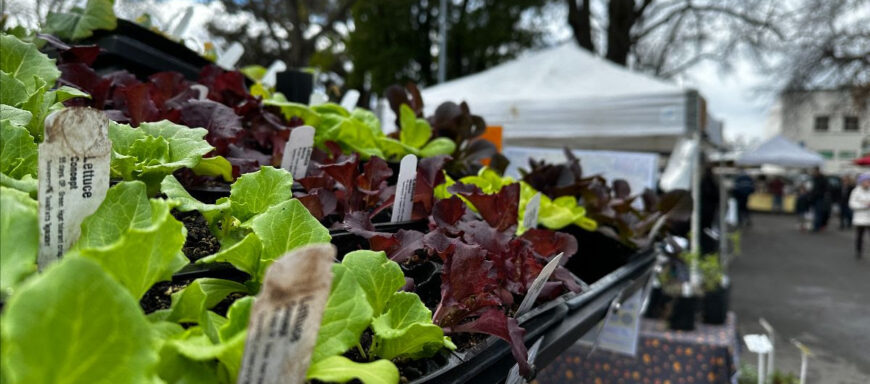Sprout & About: Your Guide to Plant Starts!
As we welcome the approach of spring, it’s an opportune moment to immerse ourselves in the world of native plants and appreciate the beauty and resilience they bring to our landscapes. Native plants play a pivotal role in maintaining the health and biodiversity of our local ecosystems. Having adapted to the specific climate, soil, and environmental conditions of our region over thousands of years, they are uniquely suited to thrive with minimal input once established.
But there’s more than just native plants flourishing at the Chico Certified Farmers Market! Alongside them, you’ll discover a vibrant array of traditional garden vegetables, berries, and herbs, including various lettuces, strawberries, dill, and more. Consider blending these native plants with your fruits and veggies to not only conserve water but also to support local wildlife and cultivate landscapes that embody the essence of California.
As temperatures start to warm up and the risk of frost decreases early spring is an ideal time to begin planting in Butte County. In March and April, plant cool-season crops such as lettuce, spinach, kale, peas, carrots, and broccoli. These crops thrive in the cooler temperatures of early spring. You can start planting perennial flowers, herbs, and fruit trees during this time, allowing them to establish roots before the summer heat sets in. For warmer-season fruits and vegetables, such as tomatoes, peppers, eggplants, cucumbers, squash, melons, and beans, wait until late spring to early summer to plant warm-season fruits and vegetables in Butte County when the soil temperature has warmed to around 60°F (15°C) or higher and the threat of frost has passed. These crops thrive in the warmer temperatures and longer daylight hours of late spring and summer. Be sure to keep soil adequately moist during planting and throughout the growing season, because as you know, Butte County experiences some really dry conditions during the summer months.
I know what you’re thinking – “This sounds great and all, but HOW do I start a garden?”. We’ve got you covered! Continue reading to find our simple guide to planting plant starts.

Guide to Planting Plant Starts
Congratulations on your decision to start gardening with plant starts! Plant starts offer a convenient way to kickstart your garden and provide a head start on the growing season. Whether you’re a beginner or a seasoned gardener, here’s a comprehensive guide to help you successfully plant your plant starts and watch them flourish:
1. Choose Your Plant Starts:
- Select healthy plant starts from reputable nurseries or garden centers. Look for sturdy stems, vibrant foliage, and well-developed roots.
- Consider factors such as your local climate, soil conditions, and available sunlight when choosing plant starts that are suitable for your garden.
2. Prepare Your Garden Bed:
- Choose a suitable location for your garden bed with adequate sunlight and well-drained soil.
- Clear the area of any weeds, rocks, or debris that may hinder plant growth.
- Amend the soil with compost or organic matter to improve its texture and fertility.
3. Planting Your Plant Starts:
- Dig holes in the garden bed that are slightly larger than the root ball of each plant start.
- Gently remove the plant starts from their containers, being careful not to damage the roots.
- Place each plant start in its respective hole, ensuring that the top of the root ball is level with the soil surface.
- Backfill the holes with soil and lightly firm the soil around the base of each plant start.
4. Watering:
- Give your newly planted plant starts a thorough watering to help settle the soil and hydrate the roots.
- Water consistently, keeping the soil evenly moist but not waterlogged. Adjust the frequency of watering based on weather conditions and the moisture needs of your plants.
5. Mulching:
- Apply a layer of mulch around your plant starts to help retain soil moisture, suppress weeds, and regulate soil temperature.
- Use organic mulches such as straw, shredded leaves, or wood chips, and spread them evenly around the base of your plants, leaving a small gap between the mulch and the plant stems.
6. Fertilizing:
- Depending on the nutrient requirements of your plants, consider incorporating organic fertilizers into the soil or applying liquid fertilizers according to package instructions.
- Avoid over-fertilizing, as this can lead to nutrient imbalances and damage to your plants.
7. Monitoring and Care:
- Keep a close eye on your newly planted plant starts for signs of stress, pests, or diseases.
- Provide support such as stakes or trellises for tall or vining plants to prevent them from falling over.
- Regularly remove weeds and dead or diseased foliage to maintain plant health and vigor.
8. Enjoying Your Garden:
- Sit back, relax, and enjoy the fruits of your labor as your plant starts grow and thrive in your garden.
- Harvest your crops when they are ripe and ready, and savor the delicious flavors of homegrown produce.
By following these steps and providing proper care and attention, you’ll be well on your way to a successful gardening season with your plant starts. Happy planting!


